Digital Media Consultant
Adapting your digital media strategy to the new realities of consumers
Digital Media Consultant
The COVID-19 health crisis has had an unprecedented economic impact. In Canada, there is talk of a GPD decline of 8.2% for the month of March 2020. The situation has prompted many retailers to seek creditor protection. At a time when lockdown measures are easing up in every province, many are wondering what comes next.
Almost every organization, from traditional businesses to start-ups, are shifting their business models towards digital to adapt to changing consumer behaviour. (Source: McKinsey, Elevating customer experience excellence in the next normal). How can we imagine what these changes will look like over the medium term and how, in the short term, will we get through the fast-approaching holiday period? It’s no secret, traditional click-and-mortar retailers are highly unlikely to reach last year’s sales numbers. A drop is coming, the question now is, how can we limit it?
Although there is no one-size-fits-all approach, this article presents possible solutions to adapt your strategy to accommodate some of the biggest changes in consumer behaviour. But first, here are three consumption habits that changed dramatically as a result of COVID-19.
Major changes in consumer behaviour linked to COVID-19
1. An explosion of e-commerce and in-store pickup
With strict lockdown measures and palpable anxiety in major city centres this spring, it was no surprise to see online sales skyrocket in Quebec. Our data science team calculated an increase of 118% in Quebec by the end of March 2020. This trend has led to an increase in home deliveries, as well as in-store and curbside pickup. Many consumers have discovered that not only do these practices feel safer, they are also a more practical way to shop. In one of its reports, Adobe Analytics points to a 62% increase in this type of practice in March of this year, compared to the same period last year. (Analysis from February 24 to March 21, 2020, compared to 2019 – Adobe Analytics, April 2020).
2. An increase in time spent online
Another lockdown-related change is the dramatic growth in time spent online, whether it’s to watch a show, a documentary, to get the latest news or to stream a workout. Given that many are likely to continue working from home for some time, and the fact that a second wave may be on its way, it would not be surprising if time spent online remained high, as the ComScore study below suggests.
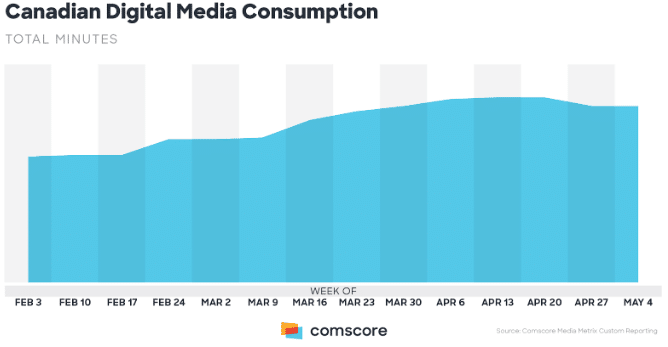
(Source: Comscore)
3. Re-prioritization of needs
In addition to new digital habits, the pandemic has also impacted consumers’ purchasing power. According to a GlobalWebIndex study, 74% of respondents believed that COVID-19 had or would impact their income.
A drop in income obviously leads to a re-prioritization of consumer needs and purchases. With that in mind, the Boston Consulting Group performed an analysis to identify which consumer products and services would be impacted the most as a result of these changes over a 6-month time frame, by the end of August. It demonstrates that spending is being rebalanced, moving towards savings and wellness products, and shifting away from travel and luxury products.
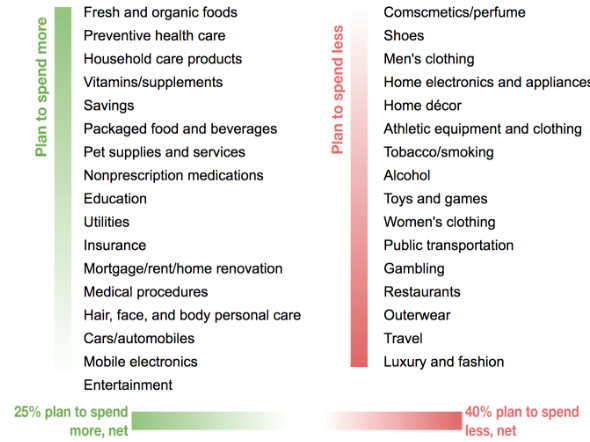
(Source: BCG)
That being said, with the current progressive deconfinement and the arrival of the end of the year period, the desire to do and have fun could allow us to see a resurgence of interest in neglected categories.
On the other hand, we see it in Quebec with Le Panier Bleu , buying local should also be a vector of demand, just like the willingness of consumers to buy from companies involved in their community. Already before the crisis, 72% of Canadians expected companies to contribute to society (Source: US – Trends 2.0 by Cowd DNA, September 2018, Canada).
HOW CAN WE FORESEE THE BEHAVIOR OF THE COMING MONTHS?
Knowing that people are ordering even more online, that they are spending more time there and that their priorities have changed, how can we foresee their behavior in the coming months? Which will last? Do we need to adapt our products and services and, if so, how? This is the magnitude of the challenge we face today.
Many products and applications intended to meet the new demand linked to the coronavirus will soon saturate the market. We will see some of these offers capture substantial demand while others fail to capture significant enough traffic.
As a solution, McKinsey's recent model of consumer behavior in the "new normal" is very interesting and makes it possible to classify behavior according to two axes:
- Growth in user volume since the crisis
- Intention to continue after the crisis
By carrying out user research, we can thus estimate the potential for certain behaviors to be maintained over time in order to adapt a business model:
ΔUsage potential in the new normal =
(X% growth in users since the start of the crisis) * (Y% willingness of users to continue)
Following the estimate of potential for use in the "new normal", the behaviors are classified within 4 categories:
- Rapid accelerators : ( Strong user growth since the crisis) * ( Strong user willingness to continue)
- Existing so far: ( High user growth since the crisis) * ( Low user willingness to continue)
- Back to normal: ( Low user growth since the crisis) * ( Low user willingness to continue)
- Potential to stay: ( Low user growth since the crisis) * ( High user willingness to continue)
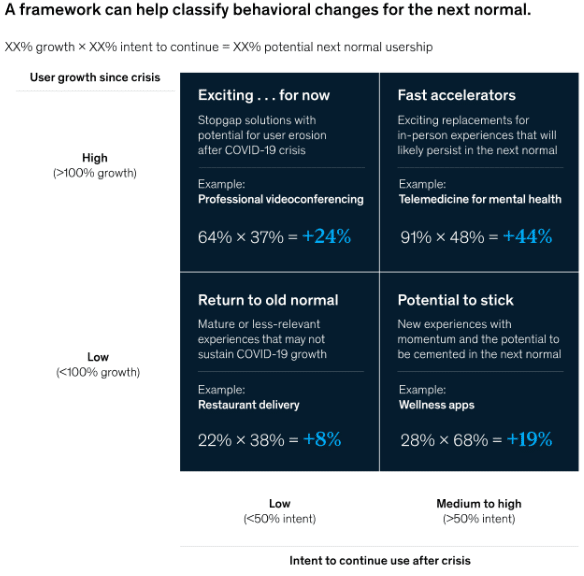
- (Source: McKinsey)
ADAPT YOUR STRATEGY TO THE NEW NORMAL
As we have seen previously, by adopting a structured methodological approach, it is possible to foresee tomorrow more serenely and to adapt its strategy to a medium and long term horizon in order to minimize the shock of a fall in the turnover. business.
STRESS-TESTING YOUR DIGITAL ASSETS
If this was not already the case, now more than ever is the time to maximize and optimize your online presence in order to have impeccable omnichannel synergy. Normally, the revenue split for retail businesses between digital and physical sales is around 15%-85%, respectively . With the rise of online shopping, businesses should expect to support major growth in orders from their digital platforms.
The past and coming months are opportunities to stress-test your digital assets and their omnichannel synergy. We've been saying it for years, but the notion of “zero friction” user experience has never been more important. Consumers expect a simple, seamless and contactless experience for their home delivery or in-store pickup.
QUESTIONING OF PHYSICAL POINTS OF SALE
The growth of online consumption being here to stay, some players such as Microsoft have chosen to close most of their stores around the world . David Porter, Group Vice President, Signs, said in a statement: "Our sales have grown online as our product catalog has grown with many digital offerings, and our great team has demonstrated their ability to serve our customers beyond physical locations.
Beyond the distribution system, this leads to the questioning of the presence of large physical retailers in formerly strategic locations such as large centers, which some might go so far as to qualify as vanity locations. With often expensive rents and operating costs and a drop in traffic to these places, is it still appropriate to maintain stores on major thoroughfares or is it better to refocus efforts on a digital presence and a system robust distribution? This is a question that all companies must ask themselves today.
IMPACT ON DIGITAL MEDIA STRATEGY
To answer this question, Google Canada teams encourage the use of the Now, Next, Later model , a planning tool used in many sectors to evaluate and adapt marketing strategies. It helps determine what actions to take now, what to focus on in the coming months, and what to focus on for the long term.
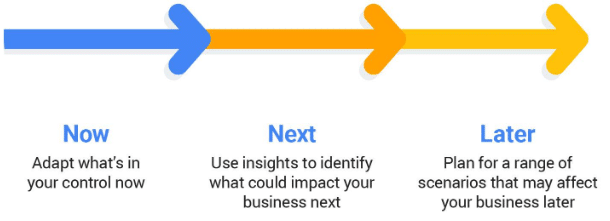
(Source: Google)
COVID-19 has created new behaviors and reinforced existing ones, such as video viewing. Between 2017 and 2019, we were already seeing a 22% increase in time spent on YouTube (Source: ComScore, video trend). With these changes and the growth of local initiatives, we can expect more questioning in the coming months among marketers regarding the strategies and distribution channels to be favored.
According to a recent study conducted by AdExchanger with specialists in the digital media industry, 18% of respondents were reassessing their digital partners specifically because of the pandemic while more than half (52%) were already reassessing their strategy and now say that the he epidemic has accelerated their digital transformation journey.
In terms of media placements, we are seeing an increase in investments in video and on social networks. With the new trend of remote work and the decline in traffic in major centers, digital outdoor signage is being neglected for other channels. (Source: 2020 Industry Outlook: How COVID-19 Reset Digital Marketing).
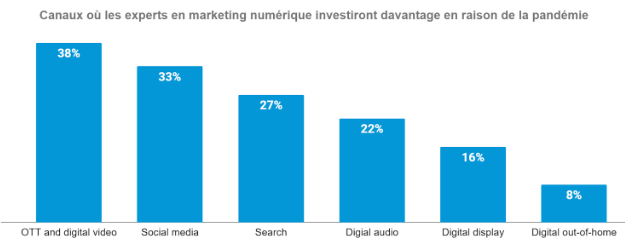
Despite a drop in investments projected for 2020 of nearly $20 billion, it is very encouraging to note that the desire to build sustainable digital assets is not empty among the experts surveyed. With a growing weight of digital in the balance, almost half will maintain or increase their investments in MarTech, Ad Tech and data technologies (Source: 2020 Industry Outlook: How COVID-19 Reset Digital Marketing).
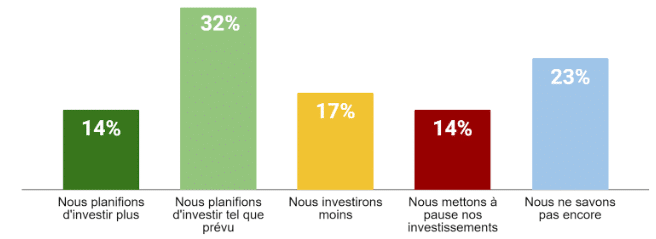
Providing a local, fluid and contactless omnichannel experience
The decline in digital investments does not mean the end of local targeting strategies, however. With health rules that may differ from one city, province or country to another comes the challenge of omnichannel cohesion. It is more important than ever to adapt your strategic approach with a hyperlocal angle. This will allow advertisers to adapt to the specific contexts of the different target geographic areas in order to maximize the potential return on investment of their marketing initiatives.
At a time when anxiety is still palpable, it will be necessary to ensure that creative approaches comply with current health rules. It may also be relevant to mention these new services and those adapted in the creative approach.
Ultimately, with price as the main incentive to buy during the end of 2019, availability and free delivery/return will be decisive factors in the buying process in 2020. Sixty-six per cent of consumers say brands should offer free services due to the pandemic. (Source: COVID-19 – COVID-19 Barometer, Kantar. Survey of 25,000 consumers in 30 markets).
The easing of quarantine measures around the world are giving the semblance of a return to normal. However, we are unlikely to return to the pre-COVID world as we knew it. The companies that successfully get through these challenging times will be those who are able to be agile and resilient in the face of constantly changing consumer behaviour.
Do you have questions about the approach your business should take? The Adviso team is here to help.




